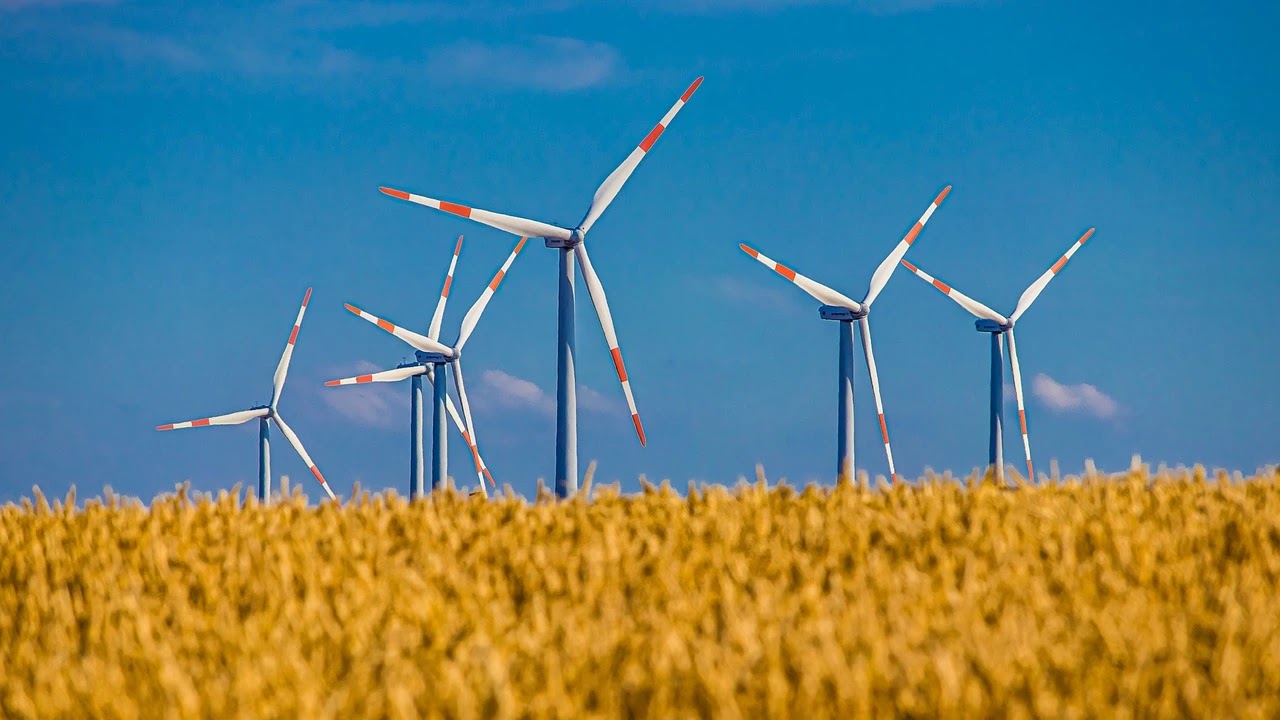What is Wind Energy?
air is called wind. About 2% of the sunlight striking the earth is converted
into the kinetic energy of moving air. Wind Energy is a Renewal Source of Energy (Non-conventional Energy).
The uneven absorption of the solar radiation by the earth’s
surface causes differences of temperature, density and pressure which produce
air movements at local, regional and global levels powered by wind energy.
Wind energy is the kinetic energy associated with the movement
of atmospheric air. Wind turbines transform the wind energy into mechanical energy,
further converting to electric energy to generate electricity.
Five nations – Germany, USA, Denmark, Spain and India – account
for 80% of the world’s installed wind energy capacity.
India rank 4th in the world with a total wind power capacity
if 1080 MW out of which 1025 MW have been established in commercial projects.
Evolution:
- As early as 4000 – 3500 BC, the first sailing ship and wind
mills were developed by harnessing wind energy. - The wind has been used to power ships, grind grains, pump
water for irrigation and do other types of work. - In present times the greatest potential for using wind is
for the production of electricity. - Wind turbines, like wind mills are mounted on a tower to
capture the most of the wind energy. Wind mills can be used to drive generators
to producing electricity. - Wind turbines can be used single or in clusters. When wind
turbines occur in clusters they are called ‘wind farms’. A wind farm can be located
onshore and offshore.
How much electricity a turbine can produce?
There are three main variables determine the production of
electricity:
1. Wind Speed- stronger winds produce more energy. Wind
turbine generates energy at a speed of 4-25 metres per second.
2. Blade Radius- the larger the radius of blades, the more the
energy produced. Doubling the blade radius can result in four times more power.
3. Air Density- Heavier air exerts more lift on a rotor. Air
density is a function of altitude, temperature and pressure. High altitude
locations have low air pressure and lighter air so they are less productive
turbine locations. The dense heavy air near sea level drives rotors faster and
thus relatively more effectively.
Two Types of Wind Turbine:
1. Horizontal-axis design has two or three blades that spin upwind
of the tower. A horizontal axis machine has its blades rotating on an axis
parallel to the ground.
2. Vertical-axis turbines has vertical blades that rotate in
and out of the wind. The vertical axis turbine has its blades rotating on an
axis perpendicular to the ground. This drag-type turbine turns relatively
slowly but yields a high torque. It is useful for grinding grain, pumping water
and many other tasks, but its slow rotational speeds are not optimal for
generating electricity. Vertical- axis turbines do not take advantage of the
higher wind speeds at higher elevations (100 feet and so) above the ground
vis-a-vis horizontal axis turbines.
Potential of Wind Energy in India:
India’s wind power potential at hub height of 120 meters is
695 GW.
The wind power installed capacity has grown by 1.8 times
during past 6.5 years to about 38.26 GW (as on 31st October 2020) and India now
has the 4th largest wind power capacity in the world.
The wind energy sector is led by the indigenous wind power
industry with a strong project ecosystem, operation capabilities and a
manufacturing base of about 10 GW per annum.
Ministry is developing strategy and roadmap to harness the
potential of offshore wind energy along India’s coastline.
The National Institute of Wind Energy (NIWE) has recently launched
Wind Energy Resource Map of India at 100 meter above ground level (AGL) on
online Geographic Information System platform.
Gujarat has the leading potential followed by Karnataka,
Maharashtra, Andra Pradesh according to the resource map.
• Tamil Nadu – 7200 MW
• Maharastra – 4000 MW
• Karnataka – 2700 MW
• Rajasthan – 2700 MW
Andra Pradesh, Madhya Pradesh, Kerala are minor players with
installed capacity of less than 1000 MW.
Government Policy for Wind Energy:
National Offshore Wind Energy Policy, 2015:
Under this Policy, the Ministry of New & Renewable
Energy (MNRE) has been authorized as the Nodal Ministry for use of offshore
areas within the Exclusive Economic Zone (EEZ) of the country and the National
Institute of Wind Energy (NIWE) has been authorized as the Nodal Agency for
development of offshore wind energy in the country and to carry out allocation
of offshore wind energy blocks, coordination and allied functions with related
ministries and agencies. It would pave the way for offshore wind energy
development including, setting up of offshore wind power projects and research
and development activities, in waters, in or adjacent to the country, up to the
seaward distance of 200 Nautical Miles (EEZ of the country) from the base line.
Scheme for Procurement
of blended Wind power from 2500 MW ISTS connected Projects:
The objective of the Scheme is to provide a framework for
procurement of electricity from 2500 MW ISTS Grid Connected Wind Power Projects
with up to 20% blending with Solar PV Power through a transparent process of
bidding. Solar Energy Corporation of India Ltd. (SECI) is the nodal agency for
implementation of the Scheme.
It has provisions for payment security mechanism, commission
schedule, power offtake constraints, power purchase agreement, etc. SECI has
awarded 970 MW of projects under this scheme at discovered tariff of Rs.
2.99-3.00 per unit.
Guidelines for Tariff Based Competitive Bidding Process for
procurement of power from Grid Connected Wind Solar Hybrid Projects:
The objective is to provide a framework for procurement of
electricity from ISTS Grid Connected Wind-Solar Hybrid Power Projects through a
transparent process of bidding.
Individual minimum size of project allowed is 50 MW at one
site and a single bidder cannot bid for less than 50 MW. The rated power
capacity of one resource (wind or solar) shall be at least 33% of the total
contracted capacity.
It has provisions for payment security mechanism, commission
schedule, power offtake constraints, power purchase agreement, etc. SECI is the
nodal agency for implementation of the Scheme.

